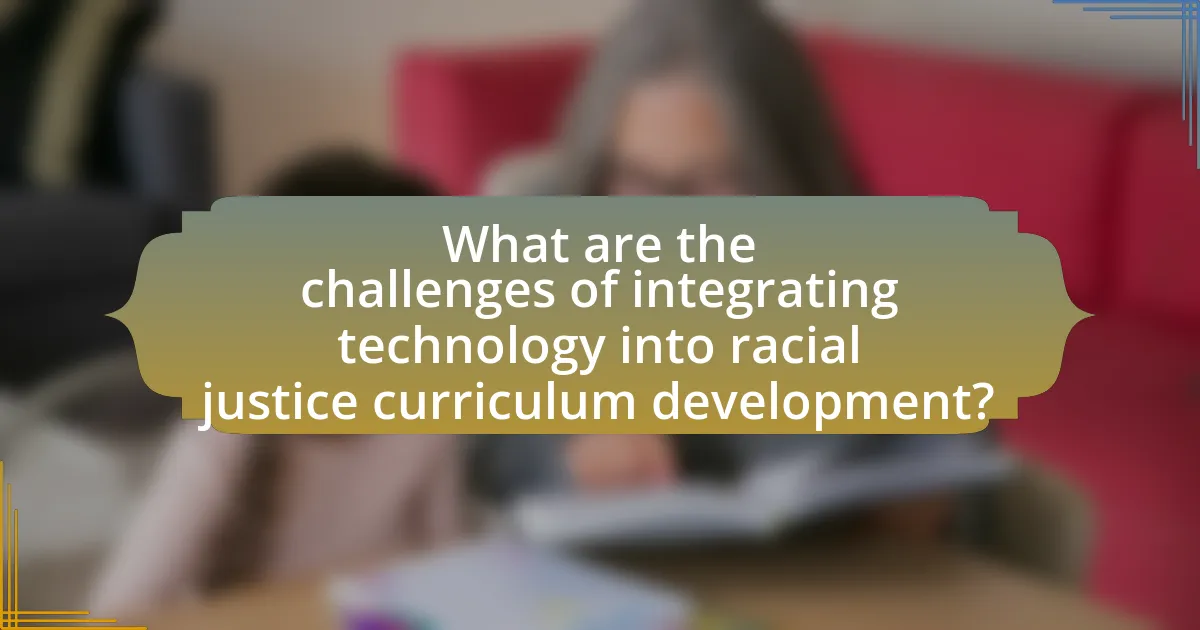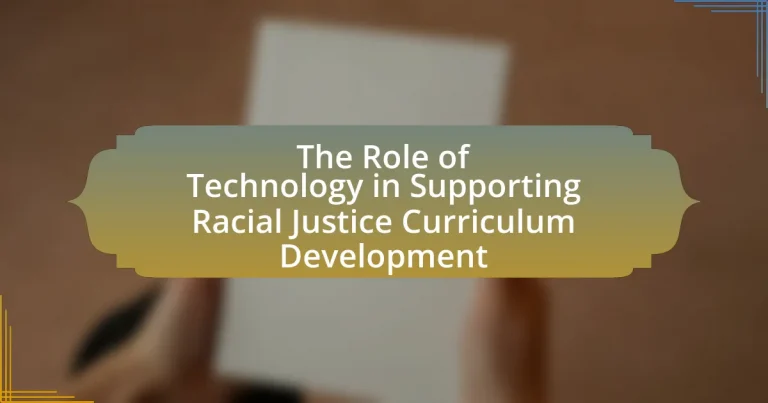The article examines the critical role of technology in supporting the development of racial justice curricula. It highlights how digital platforms enhance access to diverse resources, facilitate inclusive learning environments, and promote collaboration among educators. Key technologies discussed include online learning platforms, multimedia resources, and collaborative software, which collectively improve student engagement and understanding of racial justice issues. The article also addresses challenges such as access disparities and the need for educator training, while emphasizing best practices for integrating technology effectively into educational settings.

What is the Role of Technology in Supporting Racial Justice Curriculum Development?
Technology plays a crucial role in supporting racial justice curriculum development by providing access to diverse resources and facilitating inclusive learning environments. Digital platforms enable educators to incorporate a wide range of materials, such as multimedia content, interactive tools, and online databases, which can enhance the representation of marginalized voices in educational content. For instance, the use of virtual reality can immerse students in historical contexts related to racial justice, fostering empathy and understanding. Additionally, technology allows for collaboration among educators across different regions, enabling the sharing of best practices and resources that promote racial equity in education. Research indicates that integrating technology in curriculum development can lead to improved engagement and critical thinking skills among students, ultimately contributing to a more equitable educational landscape.
How does technology enhance racial justice education?
Technology enhances racial justice education by providing accessible resources, facilitating diverse perspectives, and enabling interactive learning experiences. Digital platforms allow educators to share materials that highlight historical injustices and contemporary issues related to race, making information readily available to a broader audience. For instance, online courses and webinars can connect students with experts in racial justice, fostering a deeper understanding of systemic inequalities. Additionally, technology enables the use of multimedia tools, such as videos and podcasts, which can engage learners more effectively than traditional methods. Research indicates that students exposed to diverse narratives through technology demonstrate increased empathy and awareness of racial issues, supporting the development of a more informed and socially conscious generation.
What specific technologies are utilized in racial justice curriculum development?
Specific technologies utilized in racial justice curriculum development include online learning platforms, multimedia resources, data analytics tools, and collaborative software. Online learning platforms like Canvas and Moodle facilitate access to educational materials and foster interactive learning environments. Multimedia resources, such as videos and podcasts, enhance engagement and provide diverse perspectives on racial justice issues. Data analytics tools enable educators to assess student performance and tailor curricula to meet diverse needs. Collaborative software, such as Google Workspace, supports group projects and discussions, promoting collective learning and understanding of racial justice topics. These technologies collectively enhance the effectiveness and reach of racial justice education.
How do these technologies facilitate learning about racial justice?
Technologies facilitate learning about racial justice by providing accessible platforms for education, fostering engagement through interactive content, and enabling diverse perspectives. Online resources, such as educational websites and social media, allow learners to access a wide range of materials, including articles, videos, and podcasts that discuss racial justice issues. Interactive tools, like virtual reality experiences and simulations, immerse users in historical contexts, enhancing empathy and understanding. Furthermore, technology enables collaboration among educators and activists, promoting the sharing of best practices and resources, which is essential for developing a comprehensive racial justice curriculum. For instance, platforms like Google Classroom and Zoom have been utilized to conduct workshops and discussions, making it easier for participants to engage with complex topics related to racial equity.
Why is technology important in addressing racial inequities in education?
Technology is important in addressing racial inequities in education because it provides access to resources and learning opportunities that can bridge gaps in educational attainment. For instance, online learning platforms and digital resources can reach underserved communities, offering high-quality educational materials that may not be available locally. Research shows that students in low-income areas benefit significantly from technology integration, as it can enhance engagement and personalize learning experiences. A study by the Pew Research Center indicates that 87% of teachers believe technology can help improve student learning, particularly for marginalized groups. Thus, technology serves as a critical tool in promoting equity by facilitating access to information and educational support.
What role does technology play in promoting inclusivity in educational materials?
Technology plays a crucial role in promoting inclusivity in educational materials by providing diverse resources and adaptive learning tools that cater to various learning needs. For instance, digital platforms enable access to a wide range of content that reflects different cultures, perspectives, and experiences, thereby fostering a more inclusive curriculum. Additionally, assistive technologies, such as screen readers and speech-to-text software, support students with disabilities, ensuring they can engage with educational materials effectively. Research indicates that inclusive educational technology can enhance learning outcomes for marginalized groups, as it allows for personalized learning experiences that accommodate individual strengths and challenges.
How can technology help in amplifying marginalized voices in the curriculum?
Technology can amplify marginalized voices in the curriculum by providing platforms for diverse narratives and facilitating access to resources that reflect varied experiences. Digital tools such as social media, online forums, and educational apps enable marginalized communities to share their stories and perspectives directly, fostering inclusivity. For instance, platforms like YouTube and podcasts allow individuals from underrepresented backgrounds to create content that can be integrated into educational materials, enriching the curriculum with authentic voices. Additionally, data shows that incorporating technology in education can enhance engagement and retention, particularly when diverse perspectives are included, as evidenced by studies indicating that students perform better when they see their identities reflected in their learning materials.

What are the challenges of integrating technology into racial justice curriculum development?
Integrating technology into racial justice curriculum development faces several challenges, including access disparities, content relevance, and educator preparedness. Access disparities arise from the digital divide, where students from marginalized communities may lack reliable internet or devices, hindering their ability to engage with technology-enhanced learning. Content relevance is another challenge, as technology must be used to create materials that accurately reflect the complexities of racial justice issues, which requires careful curation and development. Additionally, many educators may not have the necessary training or resources to effectively incorporate technology into their teaching practices, leading to inconsistent implementation and potential misalignment with racial justice goals. These challenges highlight the need for targeted strategies to ensure equitable and effective integration of technology in this critical area of education.
What barriers exist in the adoption of technology for racial justice education?
Barriers in the adoption of technology for racial justice education include limited access to resources, lack of digital literacy, and systemic inequities in educational institutions. Limited access to technology, particularly in underserved communities, restricts students’ ability to engage with digital learning tools. Research by the Pew Research Center indicates that 35% of lower-income households lack high-speed internet access, which hinders participation in online educational programs. Additionally, a lack of digital literacy among educators and students can impede effective technology integration, as many may not possess the skills necessary to utilize these tools for racial justice education. Systemic inequities within educational institutions further exacerbate these challenges, as funding disparities often result in unequal access to technological resources and training.
How do socioeconomic factors influence access to technology in education?
Socioeconomic factors significantly influence access to technology in education by determining the availability of resources such as internet connectivity, devices, and educational support. Students from lower socioeconomic backgrounds often lack reliable internet access and personal devices, which hinders their ability to engage with digital learning platforms. For instance, a report by the Pew Research Center found that 35% of lower-income households with school-age children lacked high-speed internet, compared to only 4% of higher-income households. This disparity in access creates an educational gap, as students without technology are unable to participate fully in modern learning environments, thereby affecting their academic performance and future opportunities.
What are the potential pitfalls of relying on technology in this context?
Relying on technology in the context of racial justice curriculum development can lead to several potential pitfalls, including digital divide issues, misinformation, and over-reliance on automated systems. The digital divide can exacerbate existing inequalities, as students from marginalized communities may lack access to necessary technology or internet connectivity, hindering their ability to engage with the curriculum effectively. Misinformation can proliferate through online platforms, leading to the dissemination of inaccurate or biased content that undermines the educational goals of promoting racial justice. Additionally, over-reliance on automated systems for content delivery or assessment may overlook the nuanced understanding required in discussions about race and justice, potentially reducing complex issues to simplistic metrics. These pitfalls highlight the need for a balanced approach that integrates technology while addressing its limitations.
How can educators overcome these challenges?
Educators can overcome challenges in developing a racial justice curriculum by integrating technology that facilitates access to diverse resources and promotes inclusive dialogue. Utilizing online platforms allows educators to source materials that reflect varied perspectives, ensuring a comprehensive understanding of racial justice issues. For instance, tools like digital libraries and educational websites provide access to primary sources, scholarly articles, and multimedia content that can enhance curriculum depth. Additionally, leveraging social media and discussion forums fosters community engagement and encourages students to share their experiences and insights, creating a more inclusive learning environment. Research indicates that technology-enhanced learning environments can improve student engagement and understanding of complex social issues, as highlighted in the study “The Impact of Technology on Student Engagement” by the Journal of Educational Technology.
What strategies can be employed to ensure equitable access to technology?
To ensure equitable access to technology, strategies such as increasing funding for technology infrastructure in underserved communities, providing affordable internet access, and implementing inclusive educational programs are essential. Research indicates that areas with high poverty rates often lack sufficient technological resources; for instance, a 2021 report by the Pew Research Center found that 35% of lower-income households do not have broadband internet access, which hinders educational and economic opportunities. Additionally, partnerships between schools, local governments, and technology companies can facilitate the distribution of devices and training programs, ensuring that all students, regardless of their socioeconomic status, can engage with technology effectively.
How can training and support for educators improve technology integration?
Training and support for educators significantly enhance technology integration by equipping them with the necessary skills and confidence to effectively utilize digital tools in their teaching. Research indicates that professional development programs focused on technology can lead to increased teacher efficacy and improved student outcomes. For instance, a study by the International Society for Technology in Education found that educators who received targeted training were 30% more likely to integrate technology into their lessons successfully. This integration fosters a more engaging learning environment, particularly in the context of developing a racial justice curriculum, as it allows for diverse perspectives and resources to be accessed and utilized effectively.

What best practices should be followed in utilizing technology for racial justice curriculum development?
Best practices for utilizing technology in racial justice curriculum development include ensuring inclusivity, leveraging diverse multimedia resources, and fostering interactive learning environments. Inclusivity involves integrating perspectives from various racial and ethnic groups to create a comprehensive curriculum that reflects diverse experiences. Leveraging multimedia resources, such as videos, podcasts, and interactive platforms, enhances engagement and provides varied learning modalities, which can cater to different learning styles. Fostering interactive learning environments encourages collaboration and dialogue among students, promoting critical thinking and deeper understanding of racial justice issues. Research indicates that technology-enhanced learning can improve student engagement and retention, making these practices essential for effective curriculum development.
How can technology be effectively integrated into existing curricula?
Technology can be effectively integrated into existing curricula by aligning digital tools with educational objectives and fostering interactive learning experiences. For instance, utilizing online platforms for collaborative projects can enhance student engagement and promote critical thinking. Research indicates that when technology is purposefully embedded in lessons, such as using multimedia resources to explore racial justice topics, it can lead to improved understanding and retention of complex issues. A study by the International Society for Technology in Education found that 75% of educators reported increased student motivation when technology was integrated into their teaching practices. This demonstrates that strategic use of technology not only supports curriculum goals but also enriches the learning environment.
What are the key considerations for selecting appropriate technological tools?
Key considerations for selecting appropriate technological tools include alignment with educational goals, user accessibility, and integration capabilities. Educational goals must be clearly defined to ensure that the tools support the intended learning outcomes, such as promoting racial justice awareness. User accessibility is crucial, as tools should be usable by all students, including those with disabilities, to foster an inclusive learning environment. Integration capabilities with existing systems and curricula are also important, as seamless integration enhances the overall effectiveness of the educational experience. Research indicates that tools that meet these criteria significantly improve student engagement and learning outcomes, particularly in sensitive subjects like racial justice.
How can collaboration with community organizations enhance curriculum development?
Collaboration with community organizations enhances curriculum development by integrating local knowledge and resources into educational programs. This partnership allows educators to align curriculum content with the specific cultural, social, and economic contexts of the community, making learning more relevant and impactful. For instance, research by the National Education Association indicates that schools that engage with community organizations see improved student engagement and achievement, as the curriculum reflects the lived experiences of students. Additionally, community organizations can provide access to experts and resources that enrich the curriculum, such as guest speakers, workshops, and real-world projects, thereby fostering a more comprehensive and inclusive educational experience.
What resources are available for educators developing racial justice curricula?
Educators developing racial justice curricula can access a variety of resources, including online platforms, educational organizations, and community partnerships. Notable online platforms such as Teaching Tolerance provide comprehensive materials, lesson plans, and professional development resources focused on social justice education. Additionally, organizations like the Zinn Education Project offer teaching resources that emphasize the importance of diverse perspectives in history. Community partnerships with local advocacy groups can also provide educators with real-world insights and support for implementing racial justice themes in their curricula. These resources collectively enhance educators’ ability to create impactful and relevant racial justice curricula.
Where can educators find technology tools specifically designed for racial justice education?
Educators can find technology tools specifically designed for racial justice education through platforms like Teaching Tolerance, which offers resources and lesson plans focused on social justice themes. Additionally, organizations such as the Zinn Education Project provide teaching materials that emphasize diverse perspectives and historical contexts related to racial justice. These resources are validated by their alignment with educational standards and their focus on fostering critical thinking about race and equity in the classroom.
What online platforms offer support and resources for curriculum development?
Online platforms that offer support and resources for curriculum development include Teachers Pay Teachers, Edutopia, and the Learning Network by The New York Times. Teachers Pay Teachers provides a marketplace for educators to share and sell their original teaching resources, facilitating collaboration and innovation in curriculum design. Edutopia offers articles, videos, and resources focused on best practices in education, including curriculum development strategies. The Learning Network provides teaching resources and lesson plans that incorporate current events, promoting critical thinking and engagement in curriculum development. These platforms are widely recognized for their contributions to educational resources and support for educators.
What practical tips can educators implement for successful technology integration in racial justice education?
Educators can successfully integrate technology in racial justice education by utilizing diverse digital resources, fostering collaborative online platforms, and incorporating multimedia tools. Diverse digital resources, such as articles, videos, and podcasts that highlight racial justice issues, provide students with varied perspectives and enhance understanding. Collaborative online platforms, like discussion forums or shared documents, encourage students to engage in dialogue and share insights, promoting critical thinking. Multimedia tools, including interactive presentations and visual storytelling, can effectively convey complex concepts related to racial justice, making the learning experience more engaging. Research indicates that technology-enhanced learning environments can improve student engagement and comprehension, particularly in social justice topics, thereby reinforcing the importance of these strategies in racial justice education.


